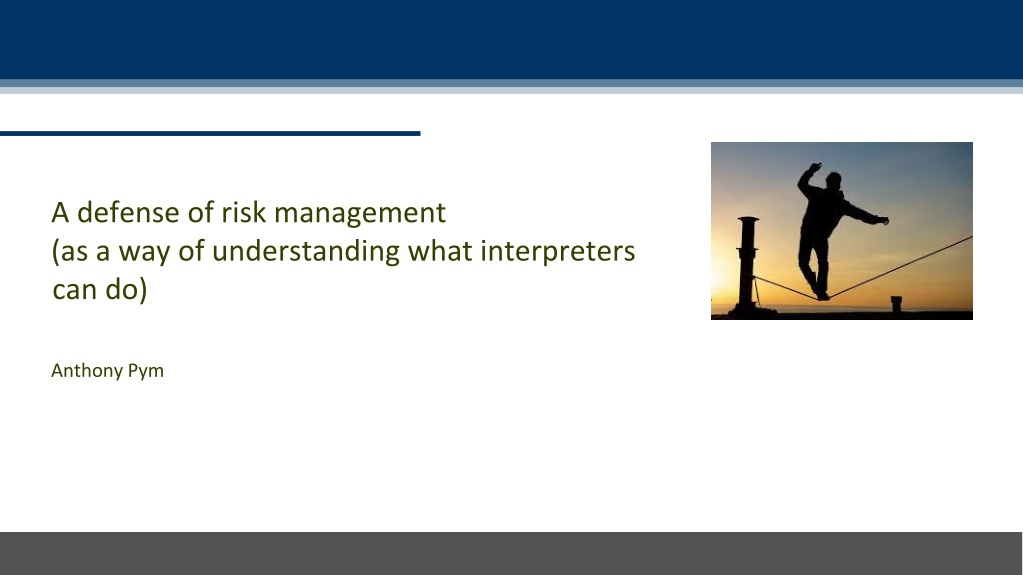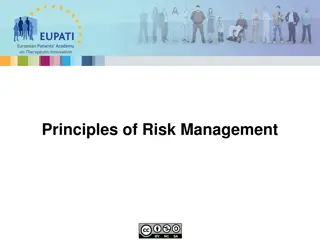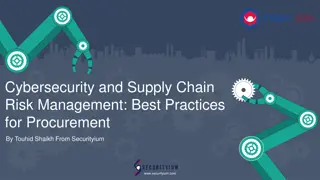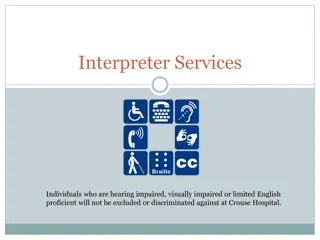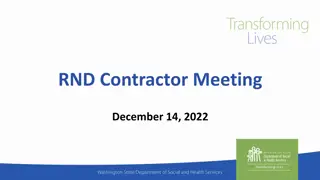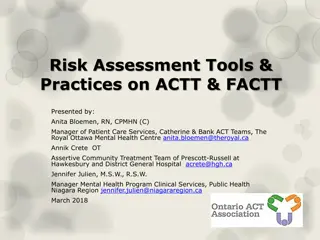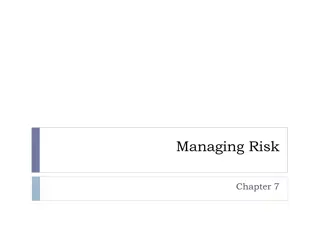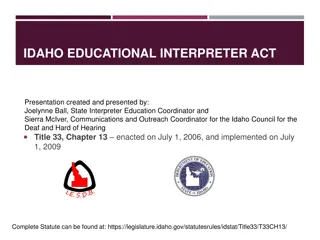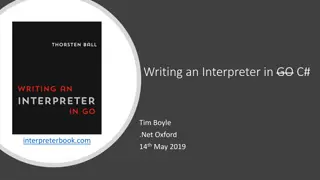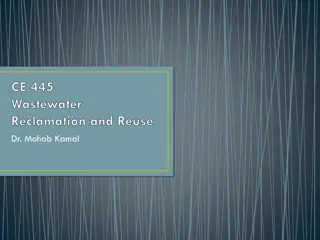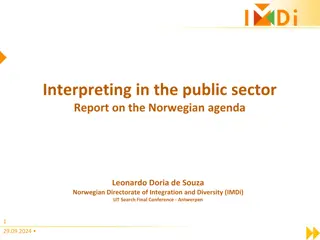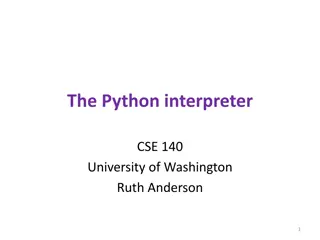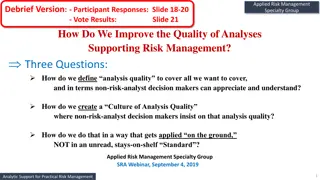An Insight into Risk Management and Interpreter Practices
Explore the intersection of risk management and interpreter roles through examples, discussions, and critiques. Delve into scenarios where risk aversion, transfer, and ethics play a crucial role in legal mediation and social environments. Question the traditional approach of equivalence-based translation and consider alternative strategies for effective communication in diverse settings.
Uploaded on Oct 09, 2024 | 0 Views
Download Presentation

Please find below an Image/Link to download the presentation.
The content on the website is provided AS IS for your information and personal use only. It may not be sold, licensed, or shared on other websites without obtaining consent from the author. Download presentation by click this link. If you encounter any issues during the download, it is possible that the publisher has removed the file from their server.
E N D
Presentation Transcript
A defense of risk management (as a way of understanding what interpreters can do) Anthony Pym
Risk-management Wilss 2005 Pym from 2004 Critiques from Gile 2021 and Halverson & Kotze 2022.
Trusting non-standard mediation 1. Judge: Entonces le pregunta si reconoce los hechos y si acepta estas condenas que pide la acusaci n. [So ask him if he agrees with what has been stated and accepts the charges made by the prosecutor.] 2. Interpreter: So, you accept the charges? 3. Defendant: To say that I robbed a wallet? 4. Interpreter: Yeah 5. Defendant: They, they have to free me? 6. Interpreter: Yep. 7. Defendant: ...to... ye-- ...free me...? 8. Interpreter: Yep. 9. Defendant: So, I have said I robbed the wallet, they have to free me. [Interpreter: Yes] out. 10. Interpreter: S , s , s , s acepta, y tienen que dejarlo en libertad. [Yes, yes, yes, he accepts, and he has to be set free.] Mediation, Interpreting and Research in Social Environment (MIRAS) Carmen Bestu Salnas (UAB) Judith Raigal Aran (URV)
Trusting non-standard mediation 1. Judge: Entonces le pregunta si reconoce los hechos y si acepta estas condenas que pide la acusaci n. [So ask him if he agrees with what has been stated and accepts the charges made by the prosecutor.] 2. Interpreter: So, you accept the charges? 3. Defendant: To say that I robbed a wallet? 4. Interpreter: Yeah 5. Defendant: They, they have to free me? 6. Interpreter: Yep. 7. Defendant: ...to... ye-- ...free me...? 8. Interpreter: Yep. 9. Defendant: So, I have said I robbed the wallet, they have to free me. [Interpreter: Yes] out. 10. Interpreter: S , s , s , s acepta, y tienen que dejarlo en libertad. [Yes, yes, yes, he accepts, and he has to be set free.] Mediation, Interpreting and Research in Social Environment (MIRAS) Carmen Bestu Salnas (UAB) Judith Raigal Aran (URV)
What is the worst thing that could happen? Judge: Defendant: More time in jail. Risk aversion: Accept the plea bargain. Interpreter: Loss of credibility Risk aversion: Ensure the outcome both sides seek. Risk transfer: Refer to previous conversation with defense counsel. Risk taking: Suppose that the previous conversation is binding. The defendant does not enter a valid plea. Risk aversion: Spells out the rules. Risk transfer: Allows side conversion. Mediation, Interpreting and Research in Social Environment (MIRAS) Carmen Bestu Salnas (UAB) Judith Raigal Aran (URV)
So what is different here? Ethics based on accuracy and role boundaries rely on equivalence. Ethics based on cooperation rely on communicative outcomes. In COVID-19 health communication in Victoria, equivalence-based translation has been slow and questioned whereas secondary elaboration by CALD communities has been effective. So can we describe and teach translation without assuming equivalence?
Pedagogical interpreting D: I: Have they done an endoscopy? Han visto dentro con una c mara? [Have they looked inside with a camera?] D: I: Did you have a miscarriage before? Perdi Ud. el beb en el embarazo? [Did you lose the baby in pregnancy?] Cortabarria, Beatriz, 2015. Non- standard Spanish in the United States and . Doctoral thesis. Universitat Rovira i Virgili.
Pedagogical interpreting D: I: in that case he may have Down syndrome. en ese caso puede tener Down syndrome. D: I: cystic fibrosis is very common. el cystic fibrosis es muy com n. D: I: If the pain bothers you we can do a TAP. Si le preocupa el dolor le haremos el TAP. Cortabarria, Beatriz, 2015. Non- standard Spanish in the United States and . Doctoral thesis. Universitat Rovira i Virgili.
Pedagogical interpreting P: I: Pregunta a ver d nde pago las tasas? [Is she asking about where I pay taxes?] S , donde paga los impuestos. [Yes, where you pay the taxes]? Cortabarria, Beatriz, 2015. Non- standard Spanish in the United States and . Doctoral thesis. Universitat Rovira i Virgili.
Whats the worst thing that can happen? Risk 1: The patient will not understand. (Short-term communication) Risk 2: The patient does not gain health literacy. (Long-term communication) Risk 2: The doctor does not trust the interpreter. (Credibility) Trade-off 1: Use common language. Trade-off 2: Use the English term the patient will need. Trade-off 3: Give the patient the correct term. Trade-off 4: Combine the above. Cortabarria, Beatriz, 2015. Non- standard Spanish in the United States and . Doctoral thesis. Universitat Rovira i Virgili.
Making judicious omissions I m sure my I don t even know these people yet but I know scientists and engineers well enough to know that they would not be very happy if I pre-announced products, but since I don t know all about what the product are, I can speak loosely I guess. I think when you look at the imaging side of Kodak, let s concentrate on that, and recognize that for the not, for the foreseeable future, as far as capture goes, that the silver halide capture media is probably the most cost-effective, highest resolution means of capturing visual memories, or visual images, that one could ask for. Gile, Daniel, 1999. Testing the Effort Models tightrope hypothesis in simultaneous interpreting - A contribution. Hermes 23: 153-172.
Making judicious omissions Gile, Daniel, 1999. Testing the Effort Models tightrope hypothesis in simultaneous interpreting - A contribution. Hermes 23: 153-172.
Making judicious omissions I m sure my I don t even know these people yet but I know scientists and engineers well enough to know that they would not be very happy if I pre-announced products, but since I don t know all about what the product are, I can speak loosely I guess. I think when you look at the imaging side of Kodak, let s concentrate on that, and recognize that for the not, for the foreseeable future, as far as capture goes, that the silver halide capture media is probably the most cost-effective, highest resolution means of capturing visual memories, or visual images, that one could ask for. Gile, Daniel, 1999. Testing the Effort Models tightrope hypothesis in simultaneous interpreting - A contribution. Hermes 23: 153-172.
Making judicious omissions I m sure my I don t even know these people yet but I know scientists and engineers well enough to know that they would not be very happy if I pre-announced products, but since I don t know all about what the product are, I can speak loosely I guess. I think when you look at the imaging side of Kodak, let s concentrate on that, and recognize that for the not, for the foreseeable future, as far as capture goes, that the silver halide capture media is probably the most cost-effective, highest resolution means of capturing visual memories, or visual images, that one could ask for. Gile, Daniel, 1999. Testing the Effort Models tightrope hypothesis in simultaneous interpreting - A contribution. Hermes 23: 153-172.
This means The interpreters made low-stakes omissions. The omissions restored in the second performance were high-stakes. So the interpreters distribute their efforts in accordance with the probability of negative outcomes ( stakes ). And omission is an effort.
This means Only work hard when the stakes are high. Don t work hard when the stakes are low. (Don t work too hard!) (These guidelines do not require equivalence.)
Teach beginners to optimize But there is also the ruse of trust
Where do you have to work hard when translating this text? When you must self-isolate You must self-isolate if you - have been tested for COVID-19 and haven t yet received your result - have been diagnosed with COVID-19 - are suspected of having COVID-19 - had close contact with a confirmed case of COVID-19, including visiting a case location - are a household member of a close contact who has yet to receive their initial negative test result - have returned from overseas and are exempt from hotel quarantine.
Where do you have to work hard when translating this text? When you must self-isolate You must self-isolate if you - have been tested for COVID-19 and haven t yet received your result - have been diagnosed with COVID-19 - are suspected of having COVID-19 - had close contact with a confirmed case of COVID-19, including visiting a case location - are a household member of a close contact who has yet to receive their initial negative test result - have returned from overseas and are exempt from hotel quarantine.
Effort is relative to technology Workflows Tasks A. Raw MT B. Light post-editing C. Heavy post-editing D. Fully human translation with no revision E. Collaborative translation (done with a group of translators) F. Fully human translation with double revision/review 1. When does curfew begin in Prague? 2. Translating today s weather report for Tasmania. 3. Translating a Russian drivers license in order to drive a school bus in Australia. 4. Translating a children s lullaby because I want my baby to sleep. 5. Translating a speech by the President of Russia. 6. I want to order some food on an English menu and I don t understand the name of the dish.
Am I telling people to be lazy? Agency is relative to opportunity: The collective simultaneous interpreters reduced the text by 23%, similar to consecutive interpreters. The public-service interpreters have fewer time constraints, thus more agency and more opportunities for situation management.
Attitudes in risk management Risk aversion Risk transfer Risk taking Trade offs
Why turn to risk management? Equivalence beliefs are fragile. Equivalence-based translators tend to be risk-averse. The market requires more than equivalence-based translation. We must train mediators who are acutely aware of contextual factors.
Giles critique makes some very good points Risk management does not explain everything. Texts are not high risk but high stakes . Risk mitigation is the same as risk aversion . Risk is more often a constraint than a driver of decision One should look at achievement-oriented decision making (Gile 2021, pp. 56, 59, 60). Gile, Daniel. (2021). Risk Management in Translation: How Much Does It Really Explain? International Journal of Interpreter Education, 13(1): 56-65.
Giles critique is essentialist Cognitive risk is of not achieving comprehension: it is the risk of making errors and omissions . In Gile, there is no positive risk-taking. Risk management is opposed to something like fidelity: It is difficult to imagine how a translated poem would look and read if it were determined to a large extent by risk management. Gile, Daniel. (2021). Risk Management in Translation: How Much Does It Really Explain? International Journal of Interpreter Education, 13(1): 56-65. (The conference interpreter knows less than the delegates.)
Halverson and Kotze have a superior product Do we really need concepts like norms and risks when we have a comprehensive usage-based theory of language? Yes, because the theory is boring and cannot be used to teach people. Halverson, Sandra, and Heide Kotze (2022). Sociocognitive constructs in Translation and Interpreting Studies (TIS). Do we really need concepts like norms and risks when we have a comprehensive usage-based theory of language?. In Sandra L. Halverson and lvaro Mar n Garc a (Eds.) Contesting epistemologies in cognitive translation and interpreting studies. pp. 51-79. Routledge.
Halverson and Kotze dont like rational assumptions Let s be blunt. The model of human behavior based on the premise that people optimize is and always has been highly implausible (Thaler, 2016) But why would you want to model human behavior? Halverson, Sandra, and Heide Kotze (2022). Sociocognitive constructs in Translation and Interpreting Studies (TIS). Do we really need concepts like norms and risks when we have a comprehensive usage-based theory of language?. In Sandra L. Halverson and lvaro Mar n Garc a (Eds.) Contesting epistemologies in cognitive translation and interpreting studies. pp. 51-79. Routledge. Risk-taking goes beyond a rational-actor model. As does the ruse of trust.
Halverson and Kotze defend linguistics this use of a straw-man argument that lies at the base of the risk management program: that linguistic approaches are incapable of catering for choice-making that is motivated by consideration of the communicative context in all its complexity. Halverson, Sandra, and Heide Kotze (2022). Sociocognitive constructs in Translation and Interpreting Studies (TIS). Do we really need concepts like norms and risks when we have a comprehensive usage-based theory of language?. In Sandra L. Halverson and lvaro Mar n Garc a (Eds.) Contesting epistemologies in cognitive translation and interpreting studies. pp. 51-79. Routledge. But I published in the Journal of Pragmatics.
Halverson and Kotze want to connect the social with the cognitive In terms of the ontological status of risk, these extensions indicate at the same time a move towards the cognitive domain and a move toward the social domain. Unfortunately, however, there is little to suggest how this complex ontology is to be understood. Halverson, Sandra, and Heide Kotze (2022). Sociocognitive constructs in Translation and Interpreting Studies (TIS). Do we really need concepts like norms and risks when we have a comprehensive usage-based theory of language?. In Sandra L. Halverson and lvaro Mar n Garc a (Eds.) Contesting epistemologies in cognitive translation and interpreting studies. pp. 51-79. Routledge. Cooperation is the social goal. Decisions are ultimately made in the interests of achieving that goal. And the rest is philosophy.
Why work on concepts? Norms solved the problem of how to synthesize isolated observations. Risk management addressed the problem of how to live with indeterminacy.
Signs of risk aversion Lexical simplification, since translations tend to use a narrower range of different words; Explicitation, since translations tend to be more redundant; Adaptation, since translations tend to adopt the discursive norms of the target culture; Unique items, items used in the TL only tend not to be used in translations in that language. Equalizing, since translations tend avoid the extremes of discursive ranges, particularly on the oral-literate continuum.
